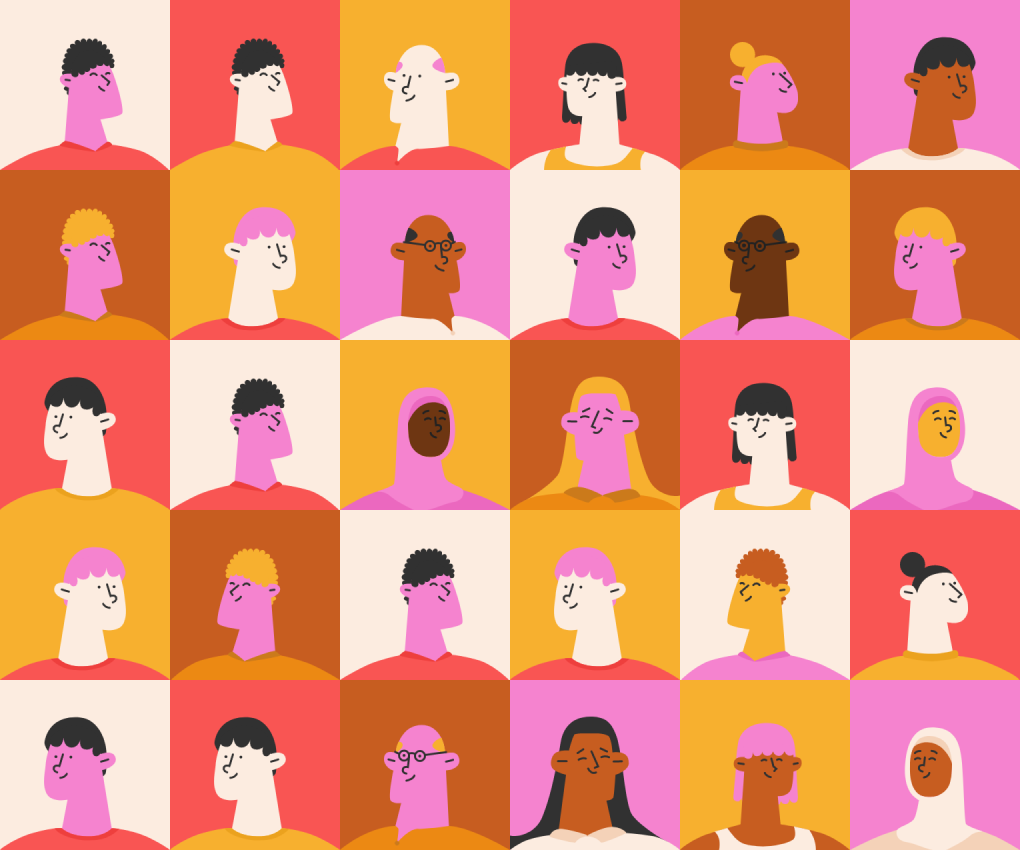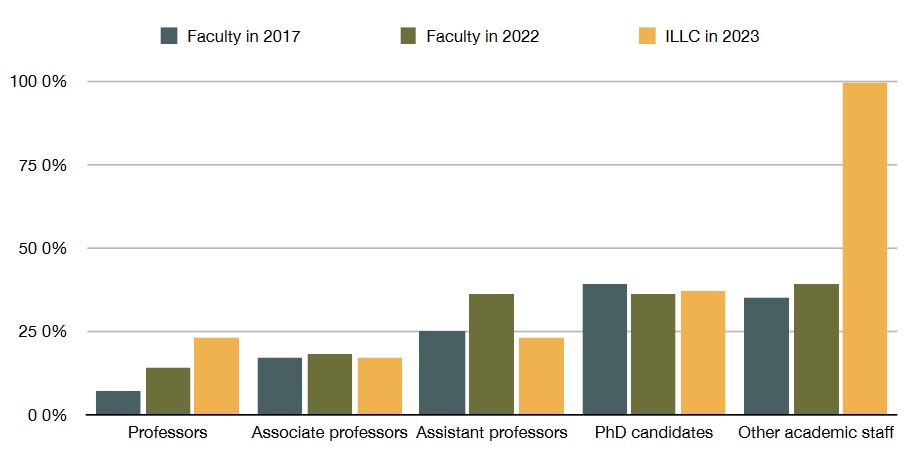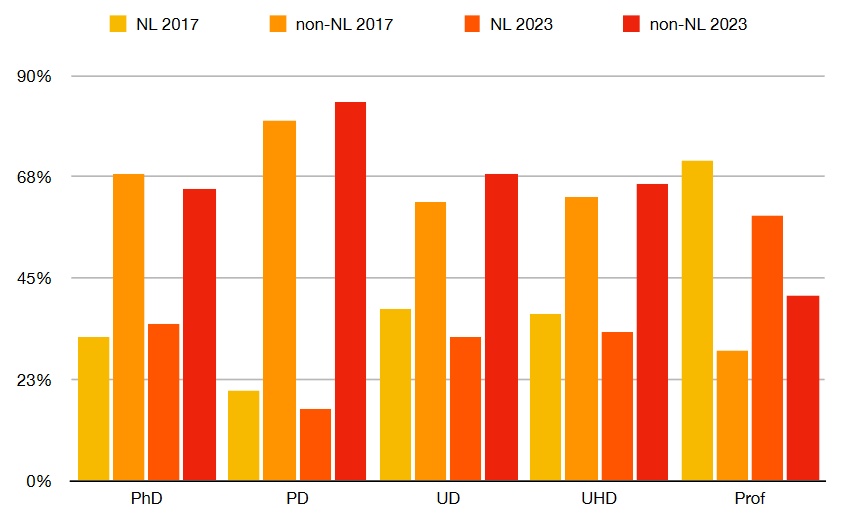6 March 2024, Alma Apt

© Arco Mul
Diversity is a concept that is perhaps best understood as an umbrella term. It spans gender, sexual identity, ethnicity, and disabilities, among others. Working on diversity therefore means addressing many different things at once. In 2020, a post on the blog discussed the ILLC’s views on diversity. At that time, a diversity committee had just been appointed. Now, several years later, it’s worth taking stock of the developments that have taken place at the ILLC in the mean time. In what ways has the diversity committee been active? What have been some of the successes and which things may still require more work?
As diversity touches on different aspects of people’s identities, there are several different topics to dive into. However, all these different aspects can play a role at the same levels: Are any irrelevant factors playing a role in hiring practices? Is there a culture in the institute in which people of different backgrounds all feel respected and treated as equals?
First, we will have a look at some data for particular groups and then go into these broader questions. It is worth noting that there is only data available for several of many possible relevant factors. This blog post will, by necessity, focus on those elements for which there is data available. The hope is that an atmosphere that is conducive to minorities in general, is also inclusive towards
groups that we have no data for.
Some data
Gender diversity
At the moment, women still make up the minority of researchers in the Netherlands. While this number has risen over the last few years – women made up only 25.2% in 2015, in 2021 this number had gone up to 30.2% – the Netherlands is still below the global average of 33%. However, looking at the numbers of engineers and researchers within the natural sciences, in the Netherlands women still only make up 25% of this group in 2023.
More specifically for the UvA: in 2022 54% of academic staff was male, making women the minority. At the Faculty of Science, this disparity is greater: 66% of all academic staff was male.
Comparing these numbers to the ILLC, specified to positions held, the comparison looks as follows:

When looking at the data, even though the ILLC is equal to or above the faculty average, there is still a gender disparity*. However, while the faculty overall demonstrates a trend of women making up a smaller contingent in higher positions, the ILLC doesn’t follow this trend.
The ILLC’s scientific director Robert van Rooij explained that this may be the result of a conscious effort to keep talented female researchers at the institute and making sure they advance to higher positions. Many of the recent hirings for professorships have gone to women. Robert mentioned that he is very happy that two women were just hired for mathematics and logic positions in the institute: Sandra Kiefer and Franziska Jahnke. For the MacGillavry fellowship positions opening up, one Assistant Professorship in Neuro-Symbolic Integration for AI and one in Social AI, the institute will be hiring two women.
There is also a delayed effect in these efforts: a larger contingent of women in the master’s will lead to more women in higher positions years down the line. At the MoL level, Robert noticed that a lot more women have applied in recent years than in the past. This bodes well for the further closing of the gender gap in the future.
Nationality
Robert mentioned that gender parity is more of an issue within the institute than diversity in nationality. However, he noted that even though the institute is very international, the managing team is still predominantly made up of people with European backgrounds. When comparing the data on the nationalities of people across positions in the institute, there have been slight shifts between 2017 and 2023. The largest change has been in the percentage of professorships held by non-Dutch people, growing from 29% to 41%. In fact, most of the positions show a slight move towards further internationalisation of the institute. The ratio of Dutch and non-Dutch PhD students is also in line with that of the MoL. Though of course not only students of the MoL do PhDs at the ILLC, it suggests that there is no bias preventing non-Dutch students from moving into academic positions.

When looking at the UvA’s master’s student population overall, there is a predominance of Dutch students. At the FNWI, this trend also holds. As all master’s degrees are in English, the language shouldn’t be forming an issue, at least for students that speak English. The student body of the Master’s of Logic (MoL) is far more diverse in nationalities than the FNWI average. The amount of Dutch students, students from the EEA (European Economic Area) and from the rest of the world
are now almost equal. The differences have shrunk since 2017, with progressively more students from the rest of the world having entered into the MoL in the last years.
While the master’s is very diverse in nationalities, Jelke Bloem, UD and member of the ILLC diversity committee, mentioned that some students noted that there are very few students from Africa. The committee hypothesised that this might be related to the financial expense. And while external scholarships are available, it may be possible that biases on the level of the allotment cause some students to be less likely to receive these scholarships.
More generally, structural factors play a role in determining the make-up of the student population in ways that are worth mentioning, even if they are beyond the purview of the department, let alone the diversity committee. Housing issues in the Netherlands, for example, make it difficult and costly for students to find housing in Amsterdam and can form an impediment to applying to the MoL.
Structural factors such as these can privilege students from more affluent backgrounds or discourage students from abroad to apply. There is no way to know how many students have opted not to apply to the MoL for such reasons, nor can the department do much to affect this.
The diversity committee discussed that there is currently limited possibility for students to work (full-time) besides studying at the MoL. The way the program is set up is not particularly conducive for this, which can be an impediment for some students that cannot support themselves financially without working. The committee mentioned it might be worth considering if more flexibility can be provided in order to allow students with less financial support to study at the MoL.
These kinds of considerations put into perspective what the institute can and cannot do to work on diversity. Issues of diversity always play out against a background of social and economic factors that are society-wide issues. The task for the institute is to try and correct for these kinds of factors where possible and not to amplify them.
The Diversity Committee
Most of the members have recently joined the Diversity Committee, meaning that there is now a new ‘iteration’ of the committee. The committee previously wrote a Social Code of Conduct specifically for the ILLC. The current members decided to build on this and write guidelines that specify what this code implies. As Karolina Krzyzanowska put it: “While it’s one thing to say: you should treat everything, everyone with respect, no matter their ethnicity, gender, or whatever identity in question, sometimes it’s not clear to people what that means”. The guidelines are a way to try and tackle a particular complexity, summarised by master’s student Amity Aharoni: “How do
you foster a culture that is inclusive and respectful, when having in mind that there’s also just constantly new people entering the institute? That is, I think, always a sort of logical problem to solve.”
The guidelines that the committee has written, such as on gender-inclusive language, are one response to this logical problem. These guidelines and information posters are displayed prominently throughout the department. In this way, people also know who the confidential advisors are that they can contact if they encounter any issues.
Another recurring message was the importance of the committee being visible in the MoL. By being present at the introductory days for new students and providing information about the Diversity Committee, they hope that students know they can contact them and that the topic is
important to the institute. The committee was happy to note that they weren’t the only people touching on the topic of diversity in the introductory talks. The committee also mentioned wanting to bring back the diversity talks, a series of lectures in which researchers whose topics pertain to the subject of diversity, presented their research.
The Diversity Committee also pointed out that, when there was a gender imbalance in the applications for the MoL, it was discussed whether this perhaps can be remedied by advertising the master’s degree more to students of Linguistics, where the gender imbalance is inversed (with more women than men in the department). This could be a way to try to correct for broader trends in society, where women are less likely to study in the field of exact sciences.
This also shows the strength of the interdisciplinary approach the ILLC takes. By attracting students who may have a background in the humanities or in the exact sciences, this allows for the possibility for a wide range of students to enter the institute. One example of the diversity that interdisciplinary approaches can engender, is the Sign Lab; a group within the ILLC studying sign language, in which several staff members are themselves members of the deaf community. This
interdisciplinarity allows for people of all kinds of background to conduct research on topics that are more varied and interesting than if the institute would be a homogeneous place.
“We cannot see all the diversity issues that are out there because we don’t have all the diverse perspectives that are in the ILLC”, said Jelke Bloem. The best thing the committee can do, they jointly stress, is to be open to input, suggestions and ideas from anyone in the institute. People can email the individual members of the diversity committee or email the committee directly.
* The internal surveys of the ILLC only included the option for other gender identities since last year, so there is no data on this as yet. The UvA also as yet does not publish data on other gender identities.